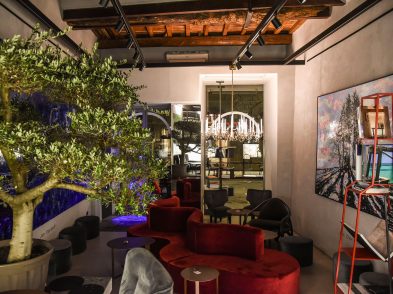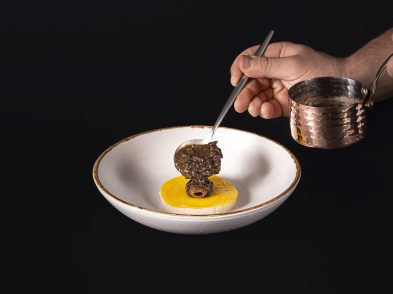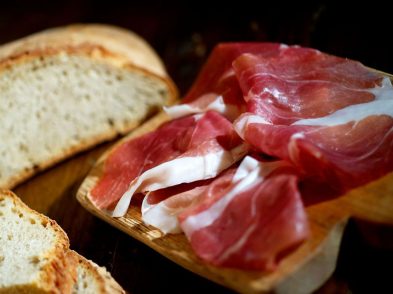Cynara was a beautiful girl, with hair the color of ash (from the Latin word for ash Cinis-cineris), and Jupiter fell desperately in love with her. You know how Jupiter was. When he fell in love, he just wanted the girl and tried every trick to conquer her, despite Juno’s anger. But Cynara refused him, and with a lightning rod the great god turned her into a vegetable, with sharp thorns that made it difficult to touch.
So goes the myth, but if you want to tread on more rational ground, the name Cynara could possibly refer to the ashes that farmers spread on the soil when growing artichokes in efforts to make the land more fertile. Add the adjective ‘Scolymus’ which means ‘full of thorns’ and you get the artichoke’s scientific name Cynara Scolymus. The artichoke has been famous since ancient Greek and Roman times: Plinius, for example, describes its therapeutic properties. But, strangely enough, the artichoke seems to have disappeared from the known world for centuries, only to reappear at the beginning of the Middle Ages in Sicily, where it was imported by the Arabs who called it Al-charschof of Al-charscoufa.
But just how did it reach Florence, the Medici family and later, the French court? It was thanks to Filippo Strozzi, the famous Florentine banker, one of the most dangerous rivals to the Medici’s economic and political supremacy in Florence. During the second half of the 15th century the Medici banished Strozzi to Naples where he established a flourishing business dedicated to trade and espionage. He established connections between Naples, Constantinople and the Eastern world. During his journeys, Strozzi also explored the territory and discovered new plants and fruits.
When he finally was allowed to return to Florence, he had gained enough wealth and influence to build the famous Strozzi palace and Villa Lo Strozzino on the slopes of Bellosguardo, where he planted all the exotic plants he had brought back from Southern Italy. Politics change quickly, of course, and one of Filippo’s sons married into the Medici family. Artichokes became well-liked in this family, so much so, that Caterina de’ Medici, niece of Lorenzo Il Magnifico, introduced them to the French royal court. When, she married Henry of Orleans, future King Henry II, she brought her own chefs and various Tuscan ingredients with her to Paris.
From March until the end of April, you find artichokes in every shop, food market and restaurant in Florence. Take a stroll to the San Lorenzo food market, climb the stairs to the vegetable section and you’ll find a huge selection of artichokes: the small violet variety from Maremma, the big round ones from Rome (called Mammole, because of their shape). You’ll see the dark green thorny ones from Sardinia, the almost violet kind from Empoli. You’ll find small carciofini that have already been cleaned and are ready to be blanched in water and vinegar and then covered with olive oil with garlic, juniper and wild mint. It’s a true festival of colors and flavors. Continue your artichoke research and discover its versatility. In restaurants, you’ll find it served in different ways and according to different recipes. Try it with carpaccio (thinly sliced raw artichoke dressed with lemon juice and olive oil). Try them fritti (cut in quarters and deep fried in olive oil).
Taste them ritti – stuffed with carnesecca (local pancetta) and nepitella (wild mint) fried and left ‘standing’ in a pot. There’s also the tortino di carciofi, where a cheese and egg mixture is combined with sautéed artichokes.
It’s a flower we eat, after we’ve cleaned the outer, most chewy leaves and the stem. What we’re left with are the soft, pale green leaves and a sweet-tasting central heart, the so-called cimarolo. A healthy vegetable with high nutritional properties, the artichoke is full of vitamins (A, B1, B2, CCP), and as a tonic, it’s famous for guaranteeing proper functioning of the liver and acts as a mild sedative. Despite its versatility, you may be surprised to know that the artichoke does have a strike or two against it. Its very agreeable taste, sweet with a bitter after-taste, makes it difficult to find the right wine to accompany it. When eaten raw, the only real choice beverage is just plain water. You can be a bit more daring if the artichoke is served in a risotto or with pasta: try a young rosé wine. Opt for a white wine when artichokes are served as a side dish.
RISOTTO CON I CARCIOFI
(Risotto with artichokes)
6 SERVINGS:
10 oz. Italian round grain rice for risotto (mostly Arborio o Semifino Vialone Nano)
5 cups beef or chicken stock
2 oz. butter
1 small white onion
2 oz. grated Parmesan cheese
6 artichokes
2 tbs. extra virgin olive oil
1 clove garlic
freshly ground white pepper
salt to taste
Clean the artichokes: take the outer leaves off, until you reach the light green ones and cut the edges. Cut the artichoke into quarters, cut the fibre off the core and put them in lemon water, so that they don’t discolour. Dry and cut them in thin slices.
Heat some olive oil in a saucepan, add the garlic and the artichokes. Let them fry on both sides, season with salt and pepper, add some stock and sauté until soft. Take half of the artichoke and process them to obtain a thick cream. Pour again in the pan together with the remaining artichoke
Heat ½ butter in a saucepan, add the onion and gently cook it for 10 minutes: the onion must not fry and should remain pale and soft. Now add the rice and toast it for 2 minutes. Pour in the wine and let the alcohol evaporate. Add the boiling stock, little by little, and cook on medium heat for at least 8 minutes, stirring from time to time.
Add the artichoke cream and the slices and cook for another 5 minutes, adding some stock, if it gets too thick. Remove the pan from the heat, add the remaining butter and the parmesan cheese to bind. Cover and let rest for two minutes before serving.
Risotto must be al dente (‘to the bite’): you should still taste the core e all’onda (‘to the wave’): it must be very soft and creamy.
TORTINO DI CARCIOFI
4 SERVINGS:
6 artichokes
1 lemon
Nepitella (wild mint, also called mentuccia, very common in Tuscany and Rome. If unavailable you can use parsley instead.)
1 clove garlic
6 eggs
2 tbsp. grated pecorino cheese
1 tbsp. whole milk
extra virgin olive oil
Clean the artichokes: take off the outer leaves, until you reach the light green ones and cut the edges. Cut the artichoke into quarters, take the fibre from the core with a knife and place in lemon water, so that they don’t discolour.
Heat some olive oil in a saucepan and add the garlic. As soon as it turns light brown, add the artichokes and fry on both sides, season with salt and pepper. Finally add some stock and sauté until soft. Remove from the pan and place in a buttered pyro-dish.
In the meantime, break the eggs into a small bowl, add a pinch of salt, some milk, the grated pecorino cheese, pepper and the finely chopped herbs. Beat with a fork for about 10 seconds. Pour the beaten eggs on the artichokes and place in the preheated oven (180°) until the egg starts curdling: tortino di carciofi should remain soft in the middle.
ENCHILADAS….by Eby’s chef Giuseppe Guerriero
Serves Four
Meat Filling
300 grams ground beef
2 carrots
1 celery stalk
1 onion
Vegetable Filling
3 carrots
2 celery stalks
1 red pepper
Broccoli
Garlic
2 white flour tortillas
Cut the tortilla into four parts. Fry pieces for a few seconds each. Take the pre-fried tortilla, fill with meat, vegetables or soft cheese. Roll, leaving the closure underneath. Place in a pan lined with oven paper. Cover with sweet peppers, tomatoes and a dallop of sour cream. Bake in oven at 180 degrees for 20 minutes.
EBY’S BAR Via dell’Oriuolo 5/r. Via Masaccio 29/r. info 055 240027




